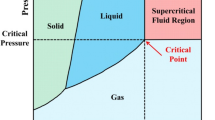Abstract
Large enhancements of the melt strength of polypropylene (PP) were achieved by the introduction of specific unsaturated linear polyester (ULP) branches using melt grafting. The transient torque curves and optical rheology microscope images indicated that branching reactions took place and the ULP had been grafted onto the PP backbone. Shear rheological behaviors of three kinds of PP were investigated using rotational rheometer under dynamic shear mode with periodic shear rate. These PP samples are foamable PP (FPP) with sparse branches obtained by grafting ULP, commercial high melt strength PP (HMS PP) for foaming and conventional linear PP (EPS). It was found that the rheological properties of FPP, the HMS PP, were distinctly different from those of conventional PP. Storage modulus, steady state compliance and zero shear viscosity increased in comparison with EPS, while shear viscosity decreased. This result implied the presence of branching structures that was not revealed in conventional PP. In melt flow measurements, extrusion swell that was a prominent behavior of branching PP was observed also for FPP and PF. Compared to linear PP, FPP and PF showed distinct sag-resistant property and lower melt flow index. On the other hand, to estimate the extent of branching, a detailed method was applied using the obtained zero shear viscosity. The result showed that FPP was grafted by sparse ULP. From these results, it was found that FPP showed obvious enhancements in rheological behaviors similar to PF, although its melt strength was lower than that of PF due to the presence of shorter branching chains grafted on the backbone of FPP.







Similar content being viewed by others
References
Sugimoto M, Masubuchi Y, Takimoto J, Koyama K (2001) Melt rheology of polypropylene containing small amounts of high molecular weight chain. I. Shear flow. J Polym Sci Polym Phys 39:2692
Huang C, Bo JY, Wu XY, Wang XY (2002) The effect of melt strength of PP on the process properties. Mod Plast Process Appl 3:9
Wang XD, Liu BG (2006) The pivotal technology in extrusion foam of PP-the processing equipment and technics. China Plast 20:20
Han CD (1985) Rheology of polymer. Science Press, Beijing
Gotsis AD, Zeevenhoven BLF, Hogt AH (2004) The effect of long chain branching on the processability of polypropylene in thermoforming. Polym Eng Sci 44:973
Esa K, Pirjo P, Jari K, Jukka VS (2001) Long-chain-branched polyethene by the copolymerization of ethene and nonconjugated α, ω-dienes. J Polym Sci Polym Chem 39:3805
Manfred R (1999) Reaction mechanism to long-chain branched PP. J Macromol Sci Pure Appl Chem 36:1759
Denicola JR, Galambos AF, Wolkowicz MD (1992) Radiation treatment of polypropylene. Polym Mater Sci Eng 67:106
Scheve BJ, Mayfield JW, Denicola JR (1990) US Patent 4916198, Himont Inc
Denicola JR (1989) E Patent 0383431B1, Himont Inc
Kashiwabara H, Shimada S, Hori Y (1991) Free radicals and crosslinking in irradiated polyethylene. Int J Radiat Appl Instrum Radiat Phys Chem 37:43
Kim KY, Kim SC (2004) Side chain extension of polypropylene by aliphatic diamine and isocyanate. Macromol Symposia 214:289
Tian JH, Yu W, Zhou CX (2006) The preparation and rheology characterization of long chain branching polypropylene. Polymer 47:7062
Tsenoglou CJ, Gotsis AD (2001) Rheological characterization of long chain branching in a melt of evolving molecular architecture. Macromolecules 34:4685
Lagendijk RP, Hogt AH, Buijtenhuijs A, Gotsis AD (2001) Peroxydicarbonate modification of polypropylene and extensional flow properties. Polymer 42:10035
Jin Y, Tan XH, Chen XY, Huang C, Zhang J (2002) The preparation of long chain branching PP. China Plast 16:24
Wang ZZ, Wu XS, Gui Z, Hu Y, Fan WC (2005) Thermal and crystallization behavior of silane-crosslinked polypropylene. Polym Int 54:442
Wang XC, Costas T, Garry LR (1996) Chemical modification of polypropylene with peroxide/pentaerythritol triacrylate by reactive extrusion. J Appl Polym Sci 61:l395
Li Y, Liu CS, Hu FZ, Zheng AN (2004) Studies of the graft-modified polypropylene and its foaming in extrusion. J Funct Polym 17:429
Liu CS, Wei DF, Zheng AN, Li Y, Xiao HN (2006) Improving foamability of polypropylene by grafting modification. J Appl Polym Sci 101:4114
Borsig E, van Duin M, Gotsis AD, Picchioni F (2008) Long chain branching on linear polypropylene by solid state reactions. Eur Polym J 44:200
Zhou CX (2003) Rheology measurement and application of polymer, Shanghai Jiao Tong University Press, Shanghai
Cao YX, Zheng Q, Du M (2005) Relationships between thermo-oxidation and dynamic rheological behavior of EPDM. Acta Polym Sin 3:407
Busse WF (1967) Mechanical structures in polymer melts. I. Measurements of melt strength and elasticity. Polym Sci Polym Phys 5:1249
Jin Y, Huang C (2002) The preparation of long chain branching PP. Chian Plast 10:25
Lu HB, Yang YL (2002) Melt rheological properties of branching polymer. Chin Poly Bull 1:16
Anneli M, Claus G, Thomas S, Helmut M, Barbro L (2002) Long-chain branching in metallocene-catalyzed polyethylenes investigated by low oscillatory shear and uniaxial extensional rheometry. Macromolecules 35:1038
Janzen J, Colby RH (1999) Diagnosing long-chain branching in polyethylenes. J Mol Struct 84:569
Justin AL, Ralph HC, Chung TCM, Fumihiko S, Toru S, Masaru A (2007) Synthesis and characterization of long chain branched isotactic polypropylene via metallocene catalyst and T-reagent. Macromolcules 40:2712
Acknowledgements
The research was supported in parts by Shanghai Fuyuan Plastic and Technology Ltd. Co. We thank Dr. Dafu Wei for contributing some EPS30R.
Author information
Authors and Affiliations
Corresponding author
Rights and permissions
About this article
Cite this article
Li, S., Xiao, M., Zheng, S. et al. The characterization of rheological properties of melt grafting polypropylene for foaming. Polym. Bull. 63, 111–123 (2009). https://doi.org/10.1007/s00289-009-0069-4
Received:
Revised:
Accepted:
Published:
Issue Date:
DOI: https://doi.org/10.1007/s00289-009-0069-4




